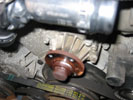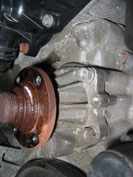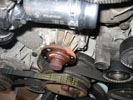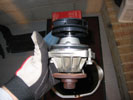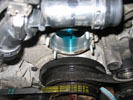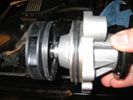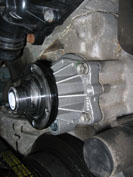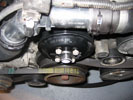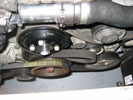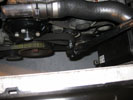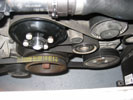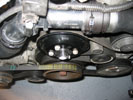
![]()
![]()
Do-It-Yourself information for the modifications I've completed
![]()
Do-It-Yourself information for essential wear and tear items
![]()
Articles covering all the ways to maintain your car
![]()
All about the BMW 330ci
![]()
Various links that I've found valuable
![]()
A few pictures of my car and some others
Complete Cooling System Overhaul
Warning!
The information provided at "Bmw330ci.net" web site is "as is" with all faults and without warranty of any kind, expressed or implied, including those of merchantability and fitness for a particular purpose, or arising from a course of dealing, usage or trade practice. "Bmw330ci.net" web site nor it's owner/creator, can not and does not provide any warranty, expressed or implied, about the accuracy or use of information found on "Bmw330ci.net" web site. The user assumes that risk.
THE USE OF THIS INFORMATION IS FOR YOUR REFERENCE ONLY. BMW330CI.NET AND ITS OWNER/CREATOR DISCLAIM ALL LIABILITY FOR DIRECT, INDIRECT, INCIDENTAL, OR CONSEQUENTIAL DAMAGES OR INJURIES THAT RESULT FROM ANY USE OF THE EXAMPLES, INSTRUCTIONS OR OTHER INFORMATION ON THIS PAGE.
Difficulty
A complete cooling system overhaul is a more difficult DIY. You will need to lift at least the front of the car to get the job done. You also need to work in tight spaces and may have difficulty getting some things apart based on the mileage of your car. It isn't difficult, but may take you a couple of hours to get everything apart and back together again successfully. If you have an automatic transmission, the removal of the fan will be different as well as some other steps, please reference some other material for proper removal and installation.
Cooling System Overhaul Discussion
Many of you know that the cooling system is weak on our cars. There are many people that have water pump failure as well as their expansion tanks, which leads to overheating (and many more problems after that). Therefore, in the name of preventative maintenance, I'm changing mine at 90k miles. This way I don't have to worry or be stranded on the side of the road. For the discussion about what water pump, the old composite OEM pump lasted 90k miles with no issues, so I have no issues with putting another one in. If you want to go with a better one that costs, that's up to you. Everyone has their own opinions, this is mine.
Tools Needed
Set Of Low Profile Ramps (To lift the front end of the car enough to drain the block)
Flexible Head Ratchet (This will help to loosen the engine block drain bolt, you can also get in a 1/4" ratchet as well)
3 Feet Of Flexible Hose 1.5" Diameter Or Greater (This will be used to run the coolant away from the engine block and your face and into the bucket.)
Large Phillips Screwdriver
Various Sockets, Extensions, and Wrenches
Rubber Mallet
Large Bucket (At least 2 gallons capacity)
Funnel
T25 And T50 Torx Bits
Parts Needed

(For those of you looking for a good deal on this whole kit, check out Tischer BMW's online deal here. They are offering free shipping for the kit and they are where I go to for my OEM part needs)
Water Pump (Part # 11-51-7-527-910) $90
Crush Washer (Part #07-11-9-963-200) $0.30
Temperature Sensor (Part #13-62-1-433-077) $19
Radiator Cap (Part #17-11-1-742-231) $14
Upper Radiator Hose (Part #17-12-7-510-952) $24
Lower Radiator Hose (Part #11-53-1-436-408) $21
Expansion Tank (Part #17-11-7-573-781) $61
Thermostat (BMW P# 11-53-7-509-227) $60
Bmw Coolant (Part #82-14-1-467-704) $15
2 Gallons of Distilled Water (These can be found at any supermarket for under a dollar each)
1 Black Zip Tie (roughly 3-4 inches long)
Table Of Contents:
1. Drain The Old Coolant
2. Remove the Hoses and Expansion Tank
3. Replace The Thermostat
4. Replace The Water Pump
5. Install New Hoses and Expansion Tank
6. Bleed And Refill Coolant
1. Drain The Old Coolant
Safely lift the front of the car
1. Using a lift or a floor jack with ramps, lift at least the front of the vehicle. Instructions for jacking up your car can be found here. This can be a very dangerous step, so make sure that the car is properly secured before ever getting under it. Never get under a car that is just supported by a jack!
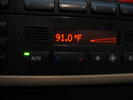 Turn on the heater |
Turn on the heater to 91 degrees at low fan speed |
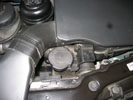 Remove the radiator cap and open the bleeder screw  Remove the radiator fill cap |
Locate radiator fill cap and loosen the bleeder screw |
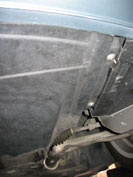 Remove the splash shield 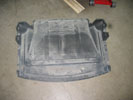 The splash shield |
Remove the splash shield underneath the engine |
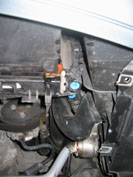 Remove the splash shield 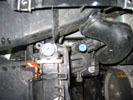 Remove the splash shield |
Locate and drain the coolant reservoir and radiator |
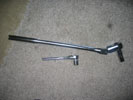 Ratchets that will fit to remove the engine block drain bolt 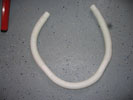 The flexible hose 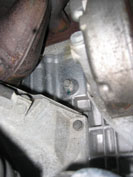 The engine block drain plug 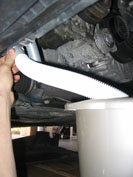 The flexible hose in action |
Locate and drain the engine block coolant |
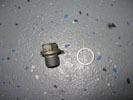 The engine block drain plug and new crush washer 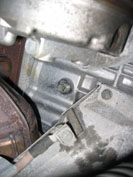 The engine block drain plug |
Replace the engine block drain plug with new crush washer |
2. Remove the Hoses and Expansion Tank
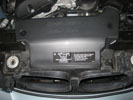 Remove the three plastic rivets 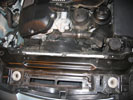 Intake tubing removed |
Remove the intake ducting |
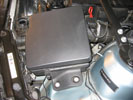 Remove the two bolts and clamp holding the air box down 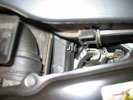 You can remove the other ducting as well  Remove the MAF connector 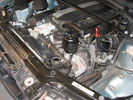 We now have plenty of room to work |
Remove the air box |
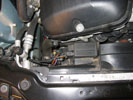 Remove the two connectors on the radiator fan 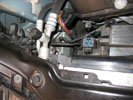 Remove the T25 screw on the passengers side 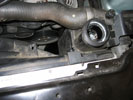 Undo the plastic rivet on the drivers side 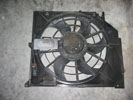 The radiator fan removed |
Remove the radiator fan |
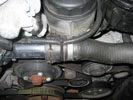 Remove the zip tie on the upper radiator hose 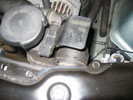 Unclip the larger connector to the expansion tank 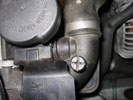 Unclip the smaller connector to the expansion tank 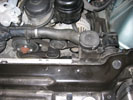 Unclip the connector on the thermostat 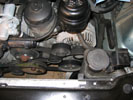 Remove the upper radiator hose |
Remove the upper radiator hose |
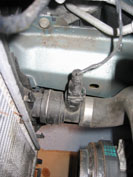 Locate the temperature sensor 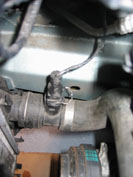 Unclip the sensors connector 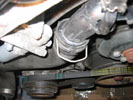 Unclip the connector to the thermostat 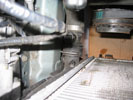 Unclip the connector to the radiator 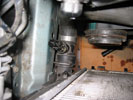 You can remove the sensor if you feel you need it to get a better grip 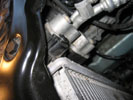 Reattach the T25 screw to keep the radiator in place |
Remove the lower radiator hose |
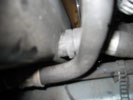 Unclip the heater core hose 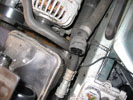 Remove the heater core hose 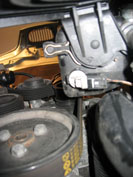 Disconnect the connector to the level sensor 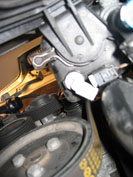 Rotate the level sensor towards the rear of the car and remove it 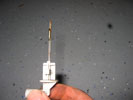 The level sensor 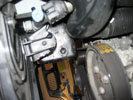 Detach the clip on the bottom of the expansion tank |
Remove the expansion tank |
3. Replace The Thermostat
(Note: These pictures are of when I replaced my thermostat awhile ago. Therefore they may not show the hoses removed, but the process is exactly the same.)
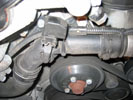 Remove the electrical connections from the thermostat 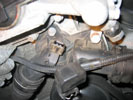 Remove the bolts on the thermostat |
Remove the wire on the thermostat |
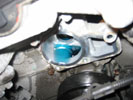 The thermostat removed 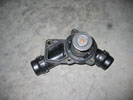 The new thermostat |
Remove the thermostat and install the new one |
4. Replace The Water Pump
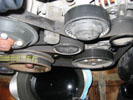 Remove the dust cap on the tensioner 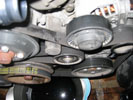 The dust cap is removed 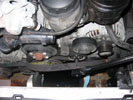 Using a large ratchet carefully loosen the belt and remove it from the tensioner |
Remove the serpentine belt |
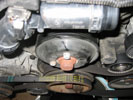 Loosen and remove the four water pump pulley bolts 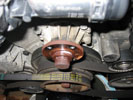 The water pump pulley removed |
Remove the water pump pulley |
|
Remove the water pump |
|
Install the new water pump |
|
Reinstall the pulley and belt |
5. Install New Hoses and Expansion Tank
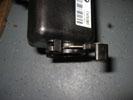 Replace the clip on the new expansion tank 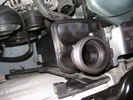 Install the new expansion tank 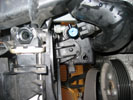 Reconnect the bottom expansion tank connector 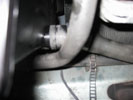 Reinstall the heater core hose 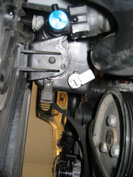 Reinstall the level sensor 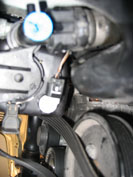 Reattach the level sensor wire |
Install the new expansion tank |
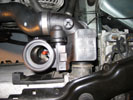 Line up and install the upper radiator hose 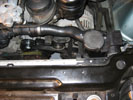 Slide down the connector clips once they are in place 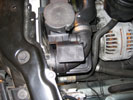 Another view of the upper radiator hose 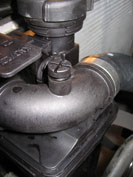 Don't forget to reopen the bleeder screw for when we add coolant again 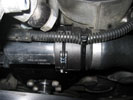 Re-zip-tie the wire onto the thermostat |
Install the upper radiator hose |
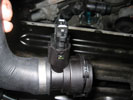 Reinstall the temperature sensor 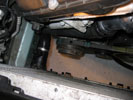 Replace the lower radiator hose 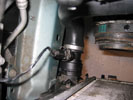 Reconnect the temperature sensor wire |
Install the lower radiator hose |
 Remove the T25 screw from the radiator 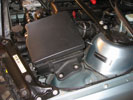 Reinstall the air box 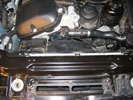 Reinstall the radiator fan 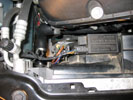 Reinstall the radiator fan connectors |
Reinstall the air box and radiator fan |
6. Bleed And Refill Coolant
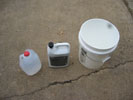 Distilled water, coolant, and bucket 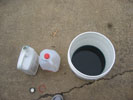 Mix them together 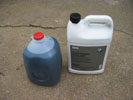 Pour them in the original jugs |
Mix the coolant with the distilled water |
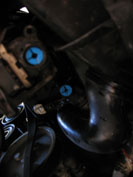 Replace and tighten the radiator and expansion tank drain plug  Turn on the heater to 91F |
Replace the engine block drain plug with new crush washer |
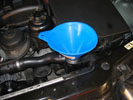 Add coolant until only coolant comes out of the bleeder screw 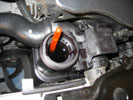 The expansion tank will appear full |
Pour the new coolant into the coolant filler cap |
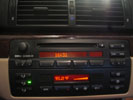 Set the thermostat to give out heat 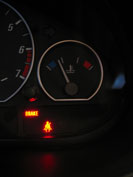 Watch the temperature gauge carefully |
Turn on the car and check for leaks |
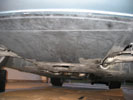 Remember to replace the splash shield 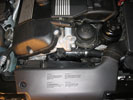 All done! |
After the engine cools down, check the coolant level |
Conclusions
This is a more complex do-it-yourself job, but now you don't need to worry about your cooling system for a long time. Many say that preventative maintenance is pointless, but I'd rather not be stranded on the side of the road. You can now keep driving without that worry in the back of your mind! Happy motoring!
Disclaimer
All product manufacturer logos are property of their respective manufacturer.
